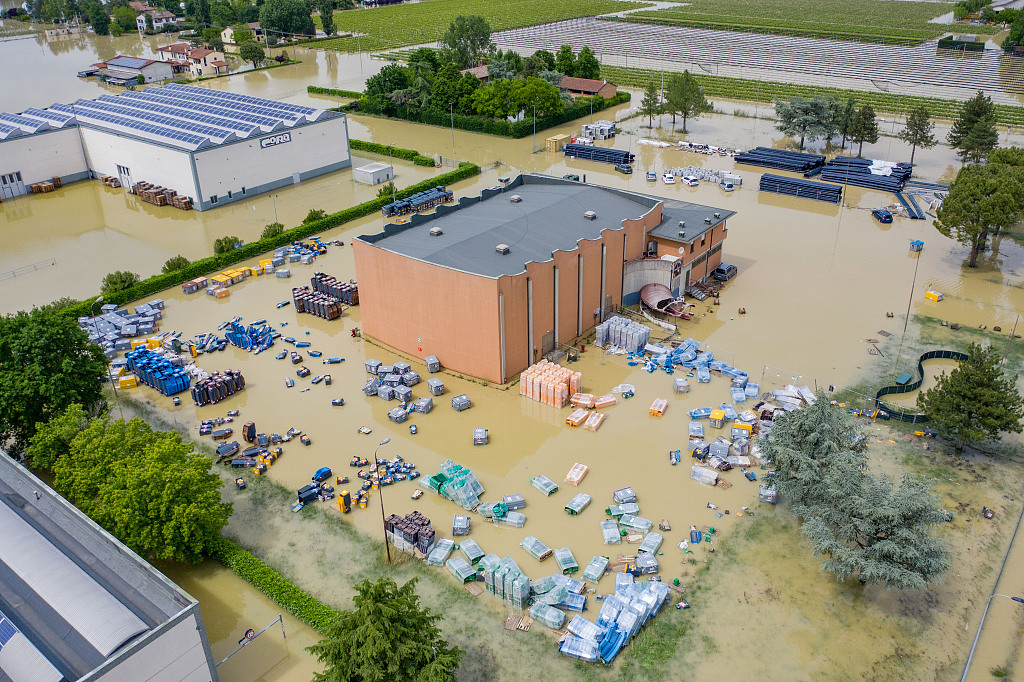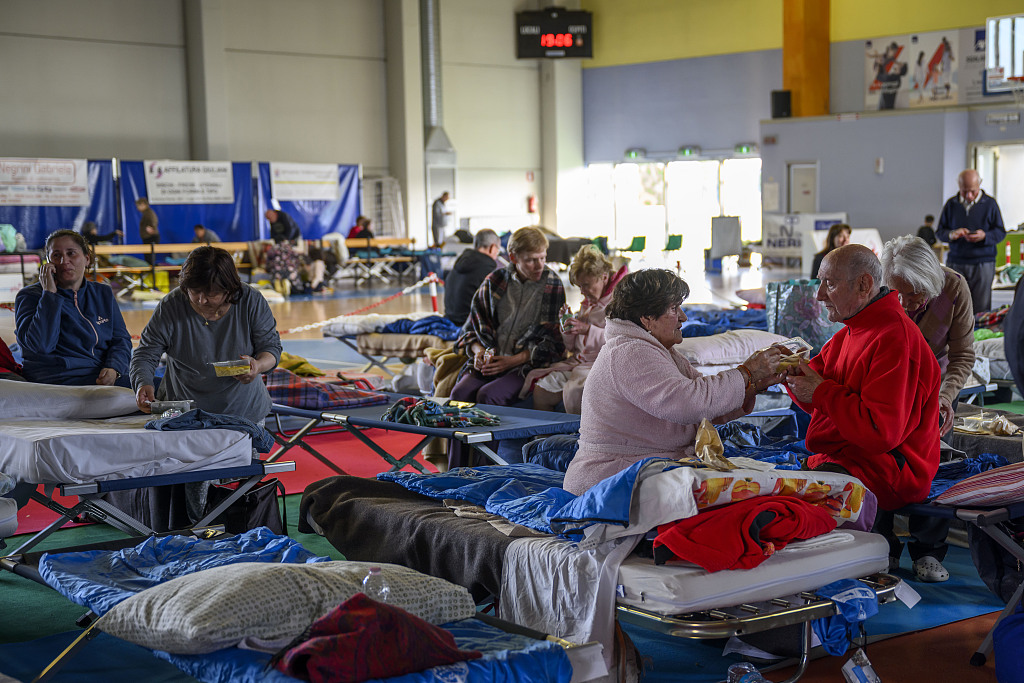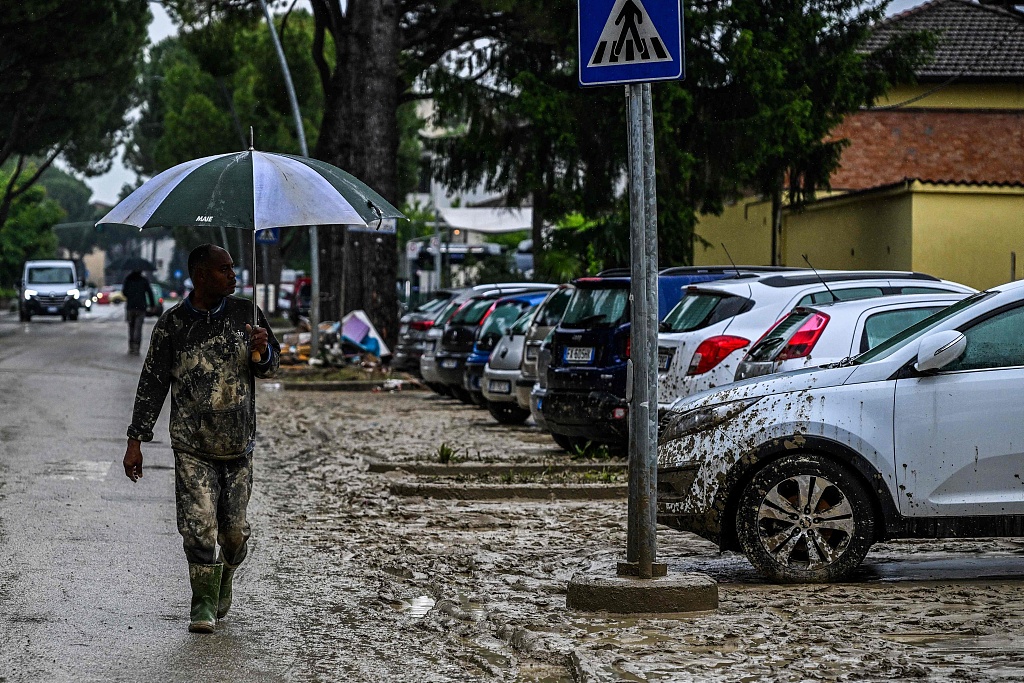The death toll from floods that have devastated the Emilia Romagna region in Italy rose to 14 on Friday, amid calls for the government to revive an abandoned project to mitigate the impact of extreme weather.
The extreme weather behind this week's disaster – a prolonged drought punctuated by 36 hours of intense rainfall, two weeks after another downpour – led to two dozen rivers and tributaries bursting their banks. The force of water sent torrents of mud tearing through entire towns in Emilia Romagna, flooding storefronts and basements.

Floodwater surrounding the Spaghetteria Fahrenheit 21 restaurant in Cotignola, in Ravenna province, northern Italy, May 18, 2023. /CFP
Floodwater surrounding the Spaghetteria Fahrenheit 21 restaurant in Cotignola, in Ravenna province, northern Italy, May 18, 2023. /CFP
Authorities in Ravenna ordered the immediate evacuation of two more small towns on Friday and issued an "extremely urgent" call for residents to reduce their movements to a minimum in the region, which was still under the highest-level "red" weather alert.
Authorities on Friday said that 43 towns were impacted by flooding and landslides, and that more than 500 roads had been closed or destroyed.
Over 15,000 people have been evacuated from their homes across the region, as farmers survey the damage that Stefano Bonaccini, the governor of the region, has compared to an earthquake. Over half the evacuees were expected to spend the night in local refuge centers set up in gyms or hotels. Others received hot meals from mobile kitchens deployed in several cities.

A general view shows displaced people at the sports centre during heavy rains caused flooding across Italy's northern Emilia Romagna region, in Lugo, Italy, May 18, 2023. /CFP
A general view shows displaced people at the sports centre during heavy rains caused flooding across Italy's northern Emilia Romagna region, in Lugo, Italy, May 18, 2023. /CFP
In a changing climate, more rain is coming, but it's falling on fewer days in less useful and more dangerous downpours.
The hard-hit Emilia Romagna region was particularly vulnerable. Its location between the Apennine mountains and the Adriatic Sea trapped the weather system this week that dumped half the average annual amount of rain in 36 hours.
"These are events that developed with persistence and are classified as rare," Fabrizio Curcio, the head of Italy's Civil Protection Agency said.
Antonello Pasini, a climate scientist at Italy's National Research Council, said a trend had been establishing itself: "An increase in rainfall overall per year, for example, but a decrease in the number of rainy days and an increase in the intensity of the rain in those few days when it rains," he said.

A resident covered in mud walks across a muddy street in Faenza, after floodwaters hit the Emilia Romagna region, Italy, May 19, 2023. /CFP
A resident covered in mud walks across a muddy street in Faenza, after floodwaters hit the Emilia Romagna region, Italy, May 19, 2023. /CFP
Italy's north has been parched by two years of drought, thanks to less-than-average snowfall during the winter months. Melting snow from the Alps, Dolomites and Apennines normally provides the steady runoff through spring and summer that fills Italy's lakes, irrigates the agricultural heartland and keeps the Po and other key rivers and tributaries flowing.
Without that normal snowfall in the mountains, plains have gone dry and riverbeds, lakes and reservoirs have receded. They cannot recover even when it rains because the ground is essentially "impermeable" and the rain just washes over the topsoil and out to the sea, Pasini said.
Civil Protection Minister Nello Musumeci said the new normal of extreme weather events in the Mediterranean requires Italians to adapt and Italy to rethink its flood protections nationwide. He cited a fierce storm-triggered landslide last fall on the southern island of Ischia, off Naples, that left 12 dead.
"We can't just pretend that nothing is happening," he said Thursday. "Everything must change: the programming in hydraulic infrastructures must change, the engineering approach must change."
(With input from agencies)
(If you want to contribute and have specific expertise, please contact us at nature@cgtn.com.)